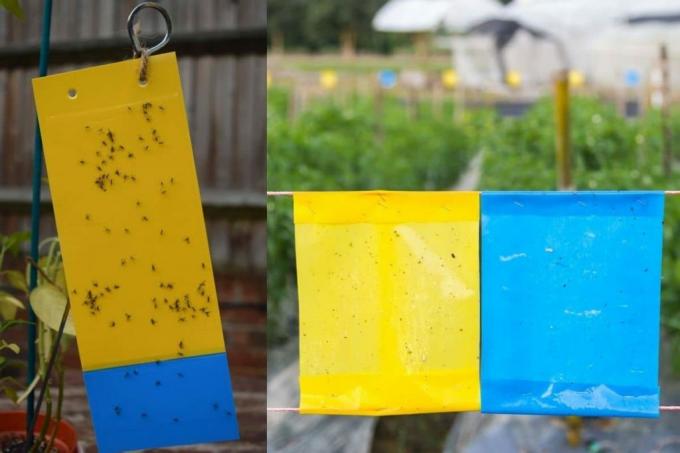
table of contents
- What are blue boards?
- Thrips (Thysanoptera)
- Advantages & disadvantages of blue boards
- Instructions for using the blue tables
- Notes on use
- Blue board marks
- frequently asked Questions
In addition to yellow panels, there are also blue panels around insects to catch and keep them from harming plants. which Pests To be caught with it and how to use the blue tables successfully, read here.
In a nutshell
- Blue tablets work just like other glue traps
- they are easy and safe to use
- however only catch thrips
- for other animals, yellow panels are better
What are blue boards?
An adhesive board consists of either a piece of cardboard or a piece of plastic coated with an adhesive. It is blue so that the right insect pests are attracted. The adhesive is weatherproof, it does not drip and lasts for a long time because it does not dry out. The boards are often perforated to make them easier to attach. As an alternative, there are the boards as plugs that are simply plugged into the ground. The only pests that can be reliably attracted by the color blue are thrips.
Thrips (Thysanoptera)
- also called fringed wings
- very many different types
- each specialized in a few plant species

Appearance
- a few millimeters in size, some winged
- Body elongated, brownish
- Larvae even smaller, whitish to greenish
- often sit on the underside of the leaf
- like a dry, warm environment, so more often in summer
- Larvae pupate in the soil
Damage image
- Thrips suck plant juices
- Shoots and leaves take care and wither, shimmering silvery
- Plant has stunted growth
- brown traces of excrement on leaves and substrate
Advantages & disadvantages of blue boards
Advantages:
- are odorless
- very safe to use
- ready for immediate use
- without insecticides
- good infestation control
- also for Houseplants
disadvantage:
- the color blue does not have a sufficient effect on other insects
- not all animals are caught
- it takes time for the pest population to decrease
- no immediate effect, animals slowly die

Note: Before using adhesive boards, you should safely determine the pests, only then will you be able to choose the right color.
Instructions for using the blue tables
- Separate the infected plants from healthy plants.
- The adhesive boards work best in an enclosed space, i.e. in a room or in a greenhouse.
- Since thrips are winged, they are best caught when they fly over the plants.
- Take the blue boards out of the packaging at the unglued area and pull a cable tie, piece of wire or something similar through the holes. Then hang it up directly above the plants. Distance about 5 to 10 cm.
- When the plants grow, the boards hang higher accordingly.
- One board is sufficient for pure inventory control and early detection for about 20 m², for combating it should only be 5 m².
- When the boards are so full of insects that they no longer stick, replace or remove.
- Dispose of the blue boards with normal household waste.
Notes on use
As with all glue traps, it cannot be ruled out with the blue ones that other animals and thus beneficial insects will stick to the glue. You reduce this risk if you only use the boards in closed rooms.
- Only apply beneficial insects when they are crawling around
- Cut glue trap with rubble foil and punch holes to hang it up
- then peel off the foil
The blue adhesive boards are not suitable for catching the larvae as they do not fly. With a little luck, the catching will still work if you place the boards directly on the substrate. However, it is important to ensure that as little soil as possible sticks to the boards. The boards come in different sizes, but that doesn't mean that bigger boards will give better results. The animals often only fly to the edge and stick there.
Blue board marks
The usual manufacturers of pesticides usually only have the classic yellow tables. You won't find any blue boards with brands like Neudorff or Substral.

Windhager
This brand offers many systems and options that help against pests. This also includes the blue adhesive boards. They are equipped with a protective film and have a hanging wire, making them very easy to use.
IVOG biotechnical systems
This manufacturer offers its blue boards with the option of documenting the intensity of the infestation. To do this, you can number the boards and enter the number of thrips caught on the associated control slip.
frequently asked Questions
Insect pests are attracted by different colors. With some animals, color doesn't work at all; there, for example, special fragrances have proven effective as attractants.
Thrips are particularly attracted by the color blue. This does not apply to other pests. Most of them prefer the color yellow and so the classic yellow tablets look better.
Soapy water treatment can be effective if the plant can tolerate it. Vegetable broths or neem oil can also help. Predatory mites also eat thrips. These beneficial insects can be bought.
The blue background is simple. All you need is a blue cardboard that is punched and laminated. The problem is likely to be a suitable adhesive. Sugar solution is recommended and is non-toxic, but it can attract other pests.



